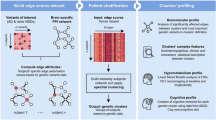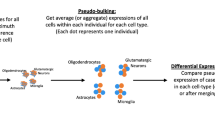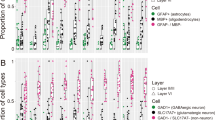Abstract
Peptidylarginine deiminases (PADIs), five isoforms of which have been identified, catalyze the conversion of arginine residues to citrulline residues in proteins. Recent studies have revealed that abnormal activation of PADI2, the gene for which is expressed throughout the nervous system, is likely to be related to the pathogenesis of neuropsychiatric diseases with neurodegenerative processes, such as Alzheimer's disease and multiple sclerosis. Such a progressive neurodegenerative process could be involved in the etiology and/or course of schizophrenia, and PADI2 may be a candidate gene for schizophrenia. To assess whether PADI2 has a role in vulnerability to schizophrenia, we conducted a two-stage case–control association study in Japanese individuals. In a screening population of 534 patients and 559 control individuals, we examined eight single-nucleotide polymorphisms (SNPs) including four haplotype tag SNPs and four coding SNPs in PADI2. There was a potential association of a synonymous SNP in exon 7 with schizophrenia. However, we could not replicate this association in a confirmatory population of 2126 patients and 2228 control individuals. The results of this study suggest that PADI2 does not contribute to genetic susceptibility to schizophrenia.
Similar content being viewed by others
Log in or create a free account to read this content
Gain free access to this article, as well as selected content from this journal and more on nature.com
or
References
Lieberman, J. A. Is schizophrenia a neurodegenerative disorder? A clinical and neurobiological perspective. Biol. Psychiatry 46, 729–739 (1999).
Pérez-Neri, I., Ramírez-Bermúdez, J., Montes, S. & Ríos, C. Possible mechanisms of neurodegeneration in schizophrenia. Neurochem. Res. 31, 1279–1294 (2006).
Vossenaar, E. R., Zendman, A. J. W., van Venrooij, W. J. & Pruijn, G. J. M. PAD, a growing family of citrullinating enzymes: genes, features and involvement in disease. BioEssays 25, 1106–1118 (2003).
Asaga, H., Akiyama, K., Ohsawa, T. & Ishigami, A. Increased and type II-specific expression of peptidylarginine deiminase in activated microglia but not hyperplastic astrocytes following kainic acid-evoked neurodegeneration in the rat brain. Neurosci. Lett. 326, 129–132 (2002).
Asaga, H. & Ishigami, A. Protein deimination in the rat brain after kainate administration: citrulline-containing proteins as a novel marker of neurodegeneration. Neurosci. Lett. 299, 5–8 (2001).
Ahmed, M. M., Hoshino, H., Chikuma, T., Yamada, M. & Kato T. Effect of memantine on the levels of glial cells, neuropeptides, and peptide-degrading enzymes in rat brain regions of ibotenic acid-treated Alzheimer′s disease model. Neuroscience 126, 639–649 (2004).
Ishigami, A., Ohsawa, T., Hiratsuka, M., Taguchi, H., Kobayashi, S., Saito, Y. et al. Abnormal accumulation of citrullinated proteins catalyzed by peptidylarginine deiminase in hippocampal extracts from patients with Alzheimer’s disease. J. Neurosci. Res. 80, 120–128 (2005).
Mastronardi, F. G., Noor, A., Wood, D. D., Paton, T. & Moscarello, M. A. Peptidyl argininedeiminase 2 CpG island in multiple sclerosis white matter is hypomethylated. J. Neurosci. Res. 85, 2006–2016 (2007).
Abecasis, G. R., Burt, R. A., Hall, D., Bochum, S., Doheny, K. F., Lundy, S. L. et al. Genomewide scan in families with schizophrenia from the founder population of Afrikaners reveals evidence for linkage and uniparental disomy on chromosome 1. Am. J. Hum. Genet. 74, 403–417 (2004).
Escamilla, M. A., Ontiveros, A., Nicolini, H., Raventos, H., Mendoza, R., Medina, R. et al. A genome-wide scan for schizophrenia and psychosis susceptibility loci in families of Mexican and Central American ancestry. Am. J. Med. Genet. B Neuropsychiatr. Genet. 144B, 193–199 (2007).
Watanabe, Y., Nunokawa, A., Kaneko, K., Muratake, T., Arinami, T., Ujike, H. et al. Two-stage case-control association study of polymorphisms in rheumatoid arthritis susceptibility genes with schizophrenia. J. Hum. Genet. 54, 62–65 (2009).
Watanabe, Y., Fukui, N., Nunokawa, A., Muratake, T., Kaneko, N., Kitamura, H. et al. No association between the ERBB3 gene and schizophrenia in a Japanese population. Neurosci. Res. 57, 574–578 (2007).
Barrett, J. C., Fry, B., Maller, J. & Daly, M. J. Haploview: analysis and visualization of LD and haplotype maps. Bioinformatics 21, 263–265 (2005).
Ke, X. & Cardon, L. R. Efficient selective screening of haplotype tag SNPs. Bioinformatics 19, 287–288 (2003).
Kimchi-Sarfaty, C., Oh, J. M., Kim, I. W., Sauna, Z. E., Calcagno, A. M., Ambudkar, S. V. et al. A ‘silent’ polymorphism in the MDR1 gene changes substrate specificity. Science 315, 525–528 (2007).
Hirakawa, M., Tanaka, T., Hashimoto, Y., Kuroda, M., Takagi, T. & Nakamura, Y. JSNP: a database of common gene variations in the Japanese population. Nucleic Acids Res 30, 158–162 (2002).
Watanabe, Y., Muratake, T., Kaneko, N., Nunokawa, A. & Someya, T. No association between the brain-derived neurotrophic factor gene and schizophrenia in a Japanese population. Schizophr. Res. 84, 29–35 (2006).
Purcell, S., Cherny, S. S. & Sham, P. C. Genetic Power Calculator: design of linkage and association genetic mapping studies of complex traits. Bioinformatics 19, 149–150 (2003).
Yamaguchi-Kabata, Y., Nakazono, K., Takahashi, A., Saito, S., Hosono, N., Kubo, M. et al. Japanese population structure, based on SNP genotypes from 7003 individuals compared to other ethnic groups: effects on population-based association studies. Am. J. Hum. Genet. 83, 445–456 (2008).
Allen, N. C., Bagade, S., McQueen, M. B., Ioannidis, J. P., Kavvoura, F. K., Khoury, M. J. et al. Systematic meta-analyses and field synopsis of genetic association studies in schizophrenia: the SzGene database. Nat. Genet. 40, 827–834 (2008).
Author information
Authors and Affiliations
Corresponding author
Rights and permissions
About this article
Cite this article
Watanabe, Y., Nunokawa, A., Kaneko, N. et al. A two-stage case–control association study of PADI2 with schizophrenia. J Hum Genet 54, 430–432 (2009). https://doi.org/10.1038/jhg.2009.52
Received:
Revised:
Accepted:
Published:
Issue date:
DOI: https://doi.org/10.1038/jhg.2009.52
Keywords
This article is cited by
-
Clinical genetic strategies for early onset neurodegenerative diseases
Molecular & Cellular Toxicology (2018)



